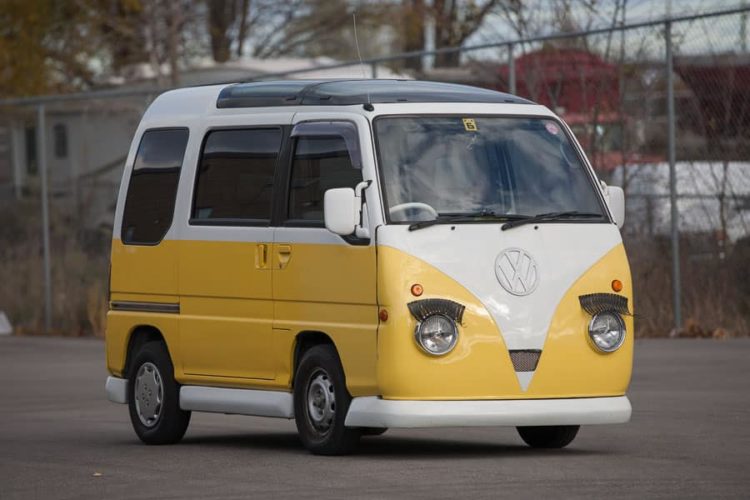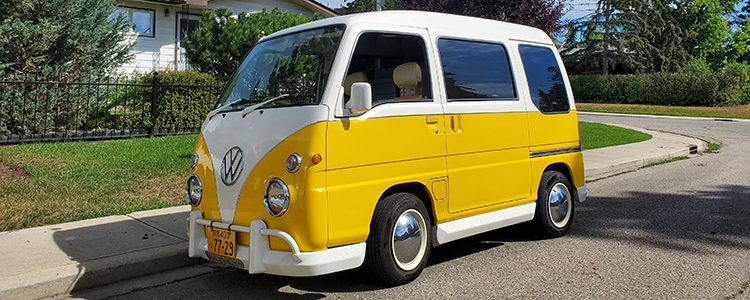Does size really matter? Yes, it does! The proof is in the Subaru Sambar. Smaller really IS better with this petite Kei car vehicle. Available in two versions, a van and a pick-up truck, this little Subaru could – and does – provides ample space for most needs.
- Virtual Tour
- Pros and Cons
- Common Issues
- Average Prices
- Comparable Alternatives
- Models and Variations
- 1961-1966 Subaru Sambar First Generation
- 1966-1973 Subaru Sambar Second Generation
- 1973-1982 Subaru Sambar Third Generation
- 1982-1990 Subaru Sambar Fourth Generation
- 1990-1999 Subaru Sambar Fifth Generation
- 1999-2012 Subaru Sambar Sixth Generation
- Compliance
- FAQ
- Resources
- How to Import a Subaru Sambar
Virtual Tour
Pros and Cons
Pros:
- Cheap and practical
- Available in 2WD and 4WD
- Reliable
- Good fuel economy
- 1990+ models were available with a supercharger
Cons:
- Parts can be difficult to find as they were not exported to North America
- Not the most practical vehicle for high-speed driving or long road trips
- Naturally aspirated models with automatic transmission are a bit underpowered
- Limited ground clearance when compared to similar Kei trucks
Common Issues

While generally regarded as reliable by owners, there are two commonly cited issues with the Sambar. The first pertains to the CVT transmission on certain models from 1990 to 1995. They suffered from a number of problems and the general consensus is to avoid them altogether as parts and finding someone capable of servicing them is quite difficult.
The second issue relates to the “Clover-4” engine used from 1990 to 2012. They were prone to oil leaks around the gaskets and seals. This is not necessarily a major concern in terms of leaks, but it should be noted.
Average Prices
Like most Kei trucks, Sambars can be found from a few thousand and go all the way up to over $10,000 dollars depending on the year, condition, and options.
Comparable Alternatives
There are several vehicles that come similarly equipped as the Sambar, some examples are:
- Honda Acty (Read our Honda Acty buying guide)
- Suzuki Carry
- Daihatsu Hijet
- Mazda Scrum
- Mitsubishi Minicab
Models and Variations
If you choose the van layout, you will realize that despite its diminutive size, it can do just about anything that other minivans and SUVs do, plus things that minivans can’t – like go off-road. If efficiency is what you seek, look no further as they are economical and can get up to 40mpg.
For those more interested in hauling their family around or camping, the Sambar is the ultimate family vehicle. With seating for five, full-time four-wheel drive, and a 660cc supercharged engine, what more could any family want?
The Sambar is equipped with either a five-speed manual transmission offering extra-low gearing or an easy-to-drive automatic. For those who like to camp out, the optional crystal lite roof and drapery help when getting away from the hustle and bustle of the city.
The pick-up form is ideal for any tradesman, such as construction workers who need to move small loads without hurting their wallets. Its size helps it get to smaller areas where larger vehicles cannot.
1961-1966 Subaru Sambar First Generation
In 1961, the first Sambar rolled off the production line. They were based on the Subaru 360 platform with an independent 4-wheel suspension and 356cc 2cyl motor that produced 18hp running. Power was put to the wheels via a 3-speed manual transmission. They were mainly marketed towards the business and commercial segments as a delivery vehicle.
1966-1973 Subaru Sambar Second Generation
The second generation saw a few minor changes along with a truck version being released. The most notable changes were: a slight increase in hp to 20, a raised roof for extra headroom, and a padded dash for safety. In addition, the motor was accessible from the outside, which made it easier to work on.
1973-1982 Subaru Sambar Third Generation
The third generation saw several improvements, most notably a bigger engine and optional 4WD starting in 1980. Early models had the same 356cc engine albeit now water-cooled. Starting in 1977, a 544cc 2cyl engine, which put out 28hp, became standard. Other features included sliding doors and an optional sunroof in 1979.
1982-1990 Subaru Sambar Fourth Generation
The fourth generation received some suspension and brake upgrades. Bigger drums were standard along with optional front-wheel disk brakes. The engine remained relatively unchanged and by the late 80s, full-time 4wd was available.
1990-1999 Subaru Sambar Fifth Generation
The fifth generation brought on a number of improvements over previous generations. Most notably was the introduction of the 658cc “Clover-4” engine which would be used all the way through 2012. Power was increased to 40hp on naturally aspirated models and a supercharged option was now available with fuel injection that put out a respectable 54hp. A 5-speed manual was standard and a CVT was available on some models. However, the CVT was dropped in 1995 due to reliability issues and replaced with a 3-speed automatic.
1999-2012 Subaru Sambar Sixth Generation
Most of the changes were cosmetic along with some safety features such as airbags and ABS brakes. There was a slight increase in horsepower in the naturally aspirated and supercharged models. Also, all N/A models were now equipped with fuel injection.
This would also be the last generation of the Subaru Sambar with the van being phased out in 2009, followed by the truck in 2012. While they still wore the Subaru nameplate, they were now made by Daihatsu.
Compliance
Compliance in Canada for the vehicle is very easy. Universal headlights fit most of models, including the Volkswagen Camper conversion model. While the stock van also fits universal headlights for safety and looks, it is recommended that E-Code headlights be installed. As with all vehicles, a daytime running light (DRL) module, amber side markers in the front, and red rear side markers are needed.
FAQ
All Subaru Sambar Generations have engines with less than 1000cc of displacement except the fifth-gen Sambar made from 1990 to 1999. It comes with a 1.2-liter EF engine, but it’s still in the Kei truck category. The first four generations have two-cylinder engines (EK series), with the largest being a 665cc EK42 engine.
The first four generations of the Subaru Sambar have a 60mph top speed, while the rest have a top speed of around 87mph for both trucks and vans.
The easiest way to check the YOM of your Subaru Sambar is first to find the VIN. It is located on the frame near the spare tire or near the bottom door hinge (kick panel) on the passenger’s side. Checking the VIN online shows you the year, month, and date of manufacture, among other credentials.
The engine code on a Subaru Sambar KT2 dump truck can be found on the right side of the engine block’s top.
Apart from the visual difference, you can also check the VIN online, which reveals the Subaru Sambar’s year, month, and date of manufacture.
Due to its weight, size, and engine capacity, the Subaru Sambar is a microvan/truck specifically in the Kei car category.
The chassis code is embedded into the VIN among the YOM and other essential details on a Subaru Sambar. Check the passenger side kicker panel or underneath the spare tire to get the VIN. You’ll find a plaque with the VIN or find the VIN written on the frame.
The frame number is commonly known as the VIN (Vehicle identification number). When checked online, it reveals all information about the car’s YOM, engine and past accidents, among other details. On a Subaru Sambar, you can find the frame number on the passenger’s side kicker panel or on the frame near the spare tire.
To fill in oil on a Subaru Sambar, you have to lift it and remove the rear bumper, giving you access to the dipstick and the oil filling cap. To drain the oil, reach for the drain plug located underneath the oil pan towards the engine’s center.
Resources
- MiniTruckTalk – Subaru Sambar Forum
- Subaru Sambar Parts – Mini Truck Parts
- Flickr – Subaru Sambar Gallery
- Wikipedia – Subaru Sambar
- https://www.tc-v.com/used_car/subaru/sambar/
- https://blog.beforward.jp/car-review/subaru-sambar.html
- https://www.deadclutch.com/2018/10/07/1991-subaru-sambar-rhd-rwd-show-van/
How to Import a Subaru Sambar
Read our ultimate guide, How to Import a Car from Japan.






Dominic Bellefeuille
April 2, 2021 at 1:20 pm
Hi
I search for complet engine Subaru sambar 1993
660cc supercharged kv4
JDMBUYSELL Staff
April 29, 2023 at 11:21 am
We recommend posting a “Wanted” ad. More info: https://www.jdmbuysell.com/where-to-buy/